Value Games
By Matthew J. Sobel, Weatherhead School of Management, Case Western Reserve University, USA, matthew.sobel@case.edu
Abstract
Large literatures in operations and economics analyze dynamic models of profit-optimizing firms. The insights and algorithms in these literatures can be adapted to maximize value if the model ignores external strategic interactions and any risk of bankruptcy. The insertion of external strategic interactions in such a model converts it to a sequential game. This work shows that the resulting sequential games are analogous to dynamic optimization models of the firm in the following sense. Insights and algorithms based on sequential games with a profit criterion and negligible bankruptcy risk can be adapted to their value-criterion counterparts. The illustrations in this work are a model of the palm oil supply chain in Indonesia and a dynamic oligopoly in which inventories affect competition between firms.
Thought-leadership in Supply Chain Finance and Risk Management
This monograph contains six thought-leading contributions on various topics related to supply chain finance and risk management. The issue culminated out of a recent (May 14-16, 2021) mini-conference on “Supply Chain Finance and Risk Management” organized by The Boeing Center for Supply Chain Innovation (BCSCI), Olin Business School, Washington University in St. Louis.
In “Quadratic Hedging and Optimization of Option Exercise Policies”, Nicola Secomandi explores a model for optimizing option exercise policies under any given equivalent martingale measure and anchoring quadratic hedging to the resulting value of the policy. In “Operations Revenue Insurance”, Paolo Guiotto, Andrea Roncoroni and Roméo Tédongap propose a new framework for the optimal design of a financial instrument to hedge nonclaimable risk embedded by business and operating revenues. In “Crowdfunding Adoption in the Presence of Word-of-Mouth Communication”, Fasheng Xu, Xiaomeng Guo, Guang Xiao and Fuqiang Zhang investigate a firm’s optimal funding choice when launching a product in the market with word-of-mouth communication. In “Data Sharing in Innovations”, Zhi Chen and Jussi Keppo discuss how the success of data-driven products depends on a firm’s access to big data and the challenges of data collection and sharing in innovations using the autonomous vehicle industry as an example. In “Coordination Problems in Platform Markets Under Uncertainty”, Hamed Ghoddusi presents a dynamic coordination problem under uncertainty that is common in platform markets and provides novel insights on this problem between two sides of a platform under uncertainty. In “Value Games”, Matthew J. Sobel shows that insights and algorithms based on sequential games with a profit criterion and negligible bankruptcy risk can be adapted to maximize value.

Companion
Foundations and Trends® in Technology, Information and Operations Management, Volume 15, Issue 3 Special Issue: Thought-leadership in Supply Chain Finance and Risk Management
See the other articles that are also part of this special issue.